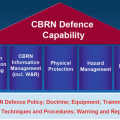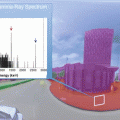ANSI/IEEE standards
IEC standards
ANSI/IEEE N42.32
IEC 62401
Performance criteria for alarming personal radiation detectors for homeland security
Radiation protection instrumentation – alarming personal radiation devices (PRD) for detection of illicit trafficking of radioactive material
ANSI/IEEE N42.33
IEC 62533
Portable radiation detection instrumentation for homeland security
Radiation protection instrumentation – highly sensitive hand-held instruments for photon detection of radioactive material
ANSI/IEEE N42.34
IEC 62327
Performance criteria for hand-held instruments for the detection and identification for radionuclides
Radiation protection instrumentation – hand-held instruments for the detection and identification of radionuclides and for the indication of ambient dose equivalent rate from photon radiation
ANSI/IEEE N42.35
IEC 62244
Evaluation and performance of radiation detection Portal monitors for use in homeland security
Radiation protection instrumentation – installed radiation monitors for the detection of radioactive and special nuclear materials at national borders
ANSI/IEEE N42.38
IEC 62484
Performance criteria for spectroscopy-based portal monitors used for homeland security
Radiation protection instrumentation – spectroscopy-based portal monitors used for the detection and identification of illicit trafficking of radioactive material
ANSI/IEEE N42.42
IEC 62755
American national standard data format for radiation detectors used for homeland security
Radiation protection instrumentation – data format for radiation instruments used in the detection of illicit trafficking of radioactive materials
ANSI/IEEE N42.43
IEC 62534
Performance criteria for mobile and transportable radiation monitors used for homeland security
Radiation protection instrumentation – highly sensitive hand-held instruments for neutron detection of radioactive material
ANSI/IEEE N42.48
IEC 62618
Performance requirements for Spectroscopic Personal Radiation Detectors (SPRDs) for homeland security
Radiation protection instrumentation – Spectroscopy-based alarming Personal Radiation Detectors (SPRD) for the detection of illicit trafficking of radioactive material
ANSI/IEEE N42.53
IEC 62694
Performance criteria for backpack based radiation detection systems used for homeland security
Radiation protection instrumentation – Backpack-type radiation detector (BRD) for detection of illicit trafficking of radioactive material
ANSI/IEEE N42.49A
American national standard for performance criteria for alarming electronic Personal Emergency Radiation Detectors (PERDs) for exposure control
The National Institute of Standards and Technology (NIST) developed different types of radioactive sources to test radiation detection systems addressed in several of these standard documents [1, 2]. The sources were designed with different objectives in mind. Some of these sources are currently commercially available with the activity values (in units of Bq) required in the standards traceable to the national standard held at NIST [1].
19.3 Document Standards Development Organizations
Document standards can be developed by different groups and organizations. Different development groups may have different focuses and needs depending on the users they represent. Some groups concentrate more on the performance requirements of a particular type of instrument, while others provide guidance for testing, use or calibration of instruments. Standards can also be developed to define specific design requirements for instruments. These groups and organizations include professional societies, trade associations, testing and certification organizations as well as national or international standards development organizations (e.g., IEC, ANSI, IEEE). The following list provides examples of such standards organizations that developed document standards for radiation detection instruments (not all inclusive):
ANSI: American National Standard Institute
ASTM: American Standards for Testing and Materials
DOD: Department of Defense
HPS: Health Physics Society
IAEA: International Atomic Energy Agency
IEC: International Electrotechnical Commission
IEEE: Institute for Electrical and Electromechanical Engineers
ISO: International Standards Organization
The standards organizations such as ANSI or IEC have different committees under which standards are developed. The standards listed in Table 19.1 were developed under the ANSI Standards N42 Committee on Radiation Instrumentation [3] and the IEC Technical Committee 45 Subcommittee B Working Group B15 (TC45B WGB15) [4].
19.4 Issues Considered During the Standards Development
The main principles behind the development of document standards are:
Transparency – need to ensure that they are accessible to all interested parties
Openness – have a broad participation from different sectors that are interested in a specific product/instrument
Impartiality – ensure that the standard does not favor a particular product or manufacturer
Stay updated, free articles. Join our Telegram channel

Full access? Get Clinical Tree






